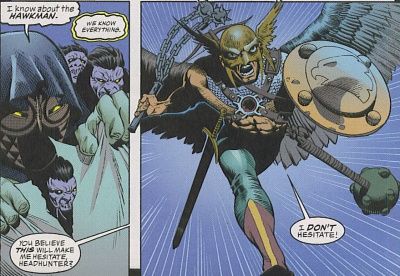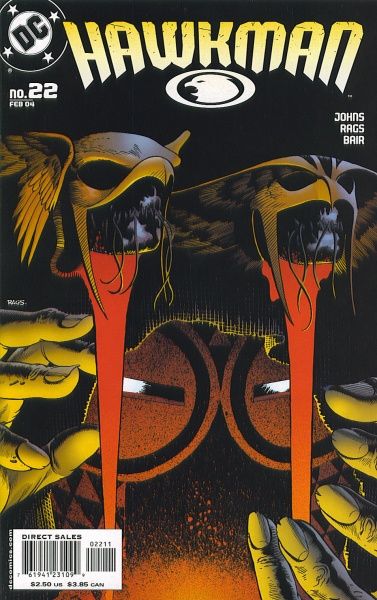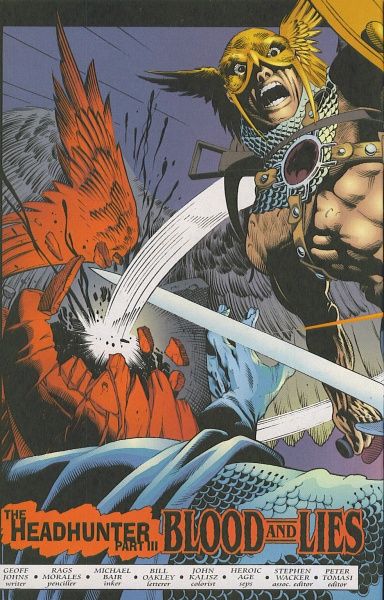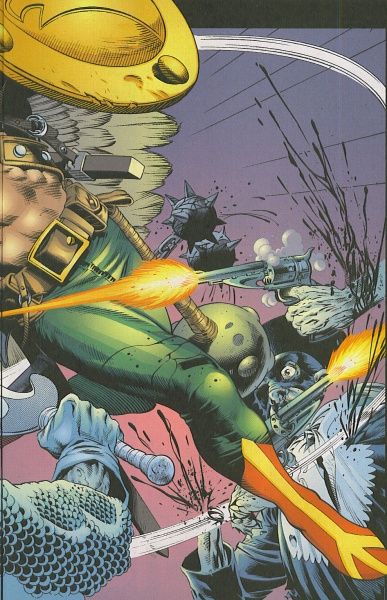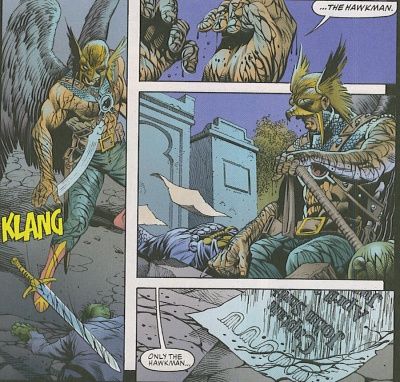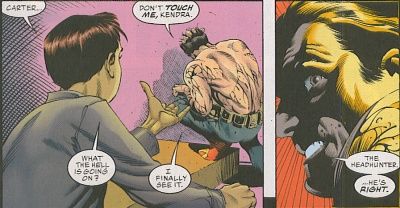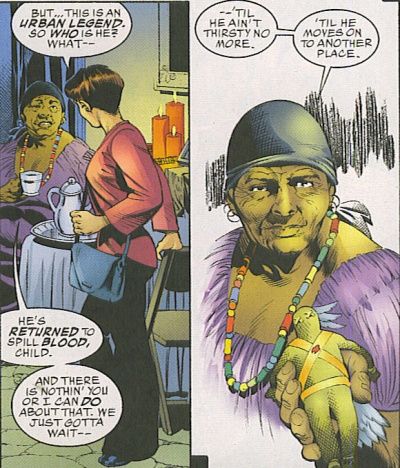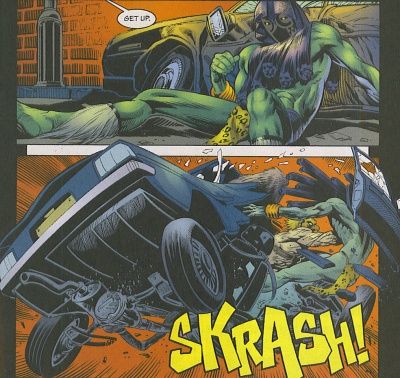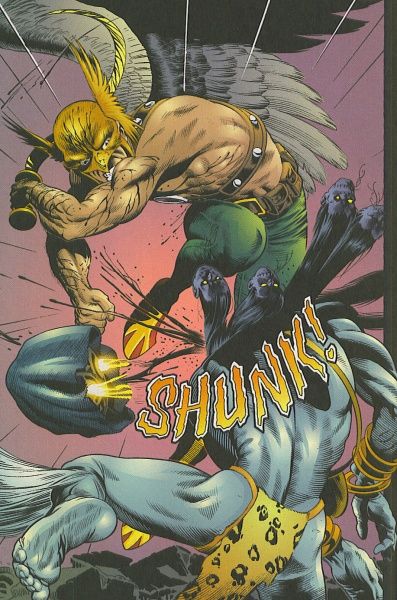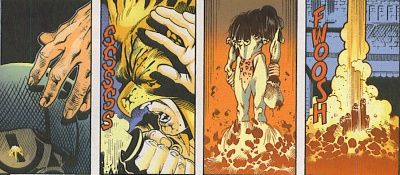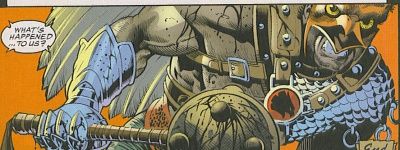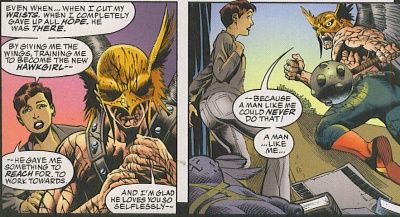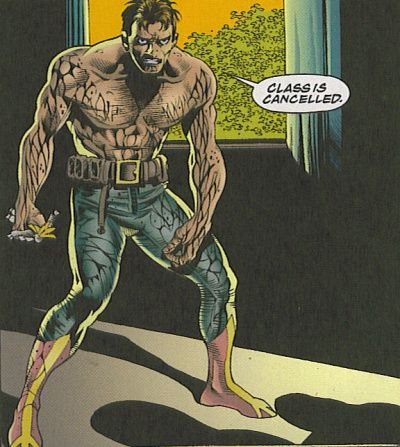Whatam I doing here?Check it out, if you don't already know!
Today: a somewhat dark and depressing comic book. Does that make it bad for new readers? We shall see!
Hawkman #22 ("The Headhunter Part III: Blood and Lies")by Geoff Johns, Rags Morales, and Michael Bair. Published by DC, February 2004.
I am not terribly squeamish when it comes to comic books. I have plenty of comic books in my possession in which one person does horrible things to another person, and I find many of them very good stories. I am currently enjoying one of the bloodiest comics in the mainstream, Moon Knight. I just wanted to point that out as we dip into Hawkman #22, which is a thoroughly bloody comic book and is rather unpleasant to boot. I will get to my contradictory attitude at the end.
First, what about the first-time comic book reader? What information do we get from this? On the first page, above a panel with Hawkman facing off against six bad guys with a seventh leading them, we get a long explanation of who Hawkman is. A long-time comic book reader would be (and has been) puzzled by the convoluted history of Hawkman, but Johns (or whoever wrote this) does as good a job as can be done:
Thousands of years ago, an Egyptian Prince and his Princess discovered an alien spacecraft from the planet Thanagar. The ship was powered by a mysterious antigravity element they called Nth metal. The unearthly energies of the Nth metal, enhanced by the strength of their love, transformed the souls of the Prince and Princess. For centuries, they were reincarnated, life after life, destined to meet one another and rekindle their love ... until today ... Today they are Carter Hall and Kendra Sanders, archaeologists and adventurers. The Winged Warriors known as HAWKMAN and HAWKGIRL!
Now, while that's certainly goofy, it at least tells a linear story that allows us to get right to the point: the main characters' names, their jobs, and their superhero names. As a long-time comic book reader, I wonder what the hell happened to Shayera, but that's not important right now. We're into the story.
We're in a graveyard, and Hawkman is facing off against what must be zombies, as one of them is dressed like an English soldier of the 17th century and another looks like an Old West gunslinger. Their leader wears a mask and carries a bunch of shrunken heads, which appear to be talking to him. Hawkman rushes his enemies, brandishing a double ball mace (or maybe it's a flail) and decked out with a sword and a different mace. On the splash page, we get a taste of the bloodshed to come. It's a very nice drawing of Hawkman among his enemies, as his swing of the mace somehow rips open the wrist of the gunslinger, wounds the gunslinger on the chest right above where his heart would be, chops off his other hand at the wrist, smashes a knight right in the face, shattering his helmet, and ends up behind Hawkman. That, to paraphrase Jerry Seinfeld paraphrasing Kevin Costner, is one magic mace! Morales lovingly shows the blood spurting from all four wounds, too.
On the next page Hawkman decapitates a foe with his shield and explains to the readers, if we haven't figured it out yet, that the bad guys are already dead, so it's okay to slaughter them. I wonder why the corpses he's fighting have blood in them, but maybe I'm thinking too much. Hawkman loses his shield (presumably it's still lodged in the bad guy's neck), but kills another bad guy with his sword, then fires a crossbow bolt into another one. The guy with the shrunken heads, meanwhile, is telling him not to "trade in [his] soul for civilization," whatever that means. Finally, Hawkman kills all the bad guys, but Shrunken Head Dude is gone. Covered with blood, Hawkman crashes to his knees. He's bummin'.
The scene shifts to "St. Roch University." We guess that this is the town in which Hawkman lives, but we don't find that out until later in the issue. A group of students congregate outside of the office of "Professor Anthony Manus" (the Hands of Fate?) whinging about their grades (it's never explained why Carter is in Professor Anthony Manus' office, or if it's his alias or not). A woman pushes her way through, muttering that she needs to talk to Carter. She opens the door and finds a bloody Hawkman standing inside, clutching what appears to be a doll (or, because he's manly, an "action figure") and glowering. "Class is cancelled," he says, and the kids scatter. The woman, Kendra, enters and asks what happened. Carter tells her not to touch him and then says, with a maniacal look in his eyes, that the Headhunter is right. He says that despite his veneer of culture, he's a creature of violence, a warrior. He implies that he and Kendra were an item, but he encouraged her to find her own path in life. Apparently, they've discussed this before, because Kendra says she wasn't saying he was a monster. He interrupts to say that this isn't about them. He adds, "For the first time in a long time, I am simply awake. For the first time in forever, I finally realize not who I am ... but what I am. I belong in a different time. A harder time." Kendra says that she's his friend, and she's not going to let him go through what she went through when her parents were murdered. We learn she was angry at everyone, but her grandfather saved her. When she tried to commit suicide, he was there to give her hope. Carter says he's glad her grandfather loves her so selflessly, because someone like him could never do that. He smashes the window as he flies away, despite Kendra calling after him. She picks up the doll, which we see is in the form of Hawkman, and yells at the curious students just for the hell of it.
Hawkman bashes a mugger on the head as he flies by, just to show he's bad-ass, but then we pick up Kendra's trail as she enters the "Voodoo District" of the city. Boy, you don't suppose there's a mysterious black woman she's going to talk to, do you? Well, of course there is! Except this woman knows Kendra through her granddaughter, who told her Kendra was coming. Kendra gives the voodoo chick, Miss Morrison, the doll, and Miss Morrison immediately knows that the Headhunter has returned to St. Roch. She tells Kendra that he's not a man, and then she launches into a history of the town. Apparently no one knows when the city was established, it just appeared one day. St. Roch attracts "lost souls, oddities, thing that can't or shouldn't exist." She explains that in the 1930s, explorers found the Jivaro tribe in Ecuador, and shrunken heads became a novelty for the rich. A legend tells of a great headhunter coming to America to infiltrate the tribes here. He wanted to find knowledge that would save his family from the commercialism of the outside world. In 1937, he killed several prominent members of St. Roch society. While he was here, however, his family and tribe abandoned the old ways and embraced the modern world, so he was left without something to protect. Miss Morrison says that since then, every few years headless corpses are found in the city. Kendra says he must be a hundred years old, and Miss Morrison says he's older than that. Kendra asks what they can do, and Miss Morrison tells her they can only wait until he's not thirsty anymore and moves on. Hawkman will have none of that!
We switch back to Carter, who's sitting on the roof of a building. Suddenly the Headhunter appears next to him, carrying a shirt and tie. He tells Hawkman to put it on, because that's his real disguise. When Carter hesitates, the Headhunter realizes that he has embraced who he really is and is now ready to join them. He tells Hawkman that progress and civilization will not corrupt Hawkman as it did his tribe. Hawkman doesn't want to talk, just fight, and he leaps at the Headhunter, knocking him off the building and to the ground. The heads tell the Headhunter to take Carter's head, but Carter bashes him with his mace. The Headhunter lies against a car, and Hawkman flies into him and drives him right through it, destroying the car in the process. I don't know why that particular panel is so ridiculous to me, as most comic book fights defy the laws of physics. But it just is.
Hawkman pulls a head off of the Headhunter's necklace and crushes it. Now he's just being mean! The Headhunter shoves his scythe into Carter's side and tells him he won't steal any more memories. As he's about to slice Hawkman in two, our hero grabs his forearm and snaps the bone in two. He wrenches the scythe from the Headhunter's grasp and slices his head clean off, in full-page glory:
As he reaches for the head, there's a bright light, and then the body, carrying the head, takes off like a rocket. Seriously:
Kendra flies down to talk to Carter, who doesn't care what she knows about the Headhunter, just that he was an enemy. Kendra tells him they need to get back to normal, and he says for him, "this is normal." The final page of the issue shows him sticking a trident in one of DC's shark bad guys, leaving a lance in the shoulder of some white supremacist dude (there's a burning cross and hooded people in the background), and smashing some other guy's face in. The last panel shows him carrying his mace covered in blood, as usual. Meanwhile, several messages on his answering machine play over the carnage. In the first, someone named "Ray" asks him to pick up the phone and says he's not going to "jump through it," he just wants to talk. In the second message, the dean at the university informs him that he's been fired, and in the last one, Kendra wonders what's going on, as he doesn't leave his loft during the day and he disappears at night. She asks, "What's happened to you? What's happened ... to us?" Oh, the drama!
Considered as part of a bigger story, this isn't bad. The violence is unpleasant, but it doesn't bother me all that much. It seems vaguely gratuitous, but not overly so. I mentioned above that I enjoy Moon Knight, and that's pretty violent, but I think it's done better in that book. But we're here to consider whether this works for someone buying a comic book for the first time. Does it do a good job laying out the particulars of the Hawkman world? For the most part, yes. We learn about Carter's city and his job and his problems with adjusting to a world where warriors aren't really the heroes they used to be. Johns fails to really give us the actual relationship between Carter and Kendra - are they former lovers, just friends, teacher and student? We don't know. He implies that they were once lovers, but we don't know. The Headhunter's origin is explained, but we have no idea why he appears supernatural. Miss Morrison implies that he is, but we have no clue why he's able to live so long or survive having his head cut off. The issue also leads into a bigger story, which is fine if you're a regular reader, but might bother a first-timer who is looking for some sort of resolution. It's a question of whether you're interested enough with what you've read so far.
The biggest problem Hawkman #22 has in drawing in new readers is how unpleasant it is. To go back to Moon Knight: I like it, but I'm probably not recommending it for a new reader. Hawkman does not act like a hero at all in this comic, and the bloodshed is a bit much. If you're looking for a comic book with a superhero fighting bad guys, you're not going to find it here. This is a thoroughly depressing comic in which the titular character basically goes insane. Johns can spin it that he's "reclaiming his warrior roots," but he doesn't believe that, and neither does Morales, who often draws Carter with "crazy eyes" (Morales' art in the issue is very good, by the way). It's not even that well-written a descent into madness, either. Despite the fact that it's not a bad issue in a long-running title, it's not like Johns is writing King Lear or anything. He takes the short cut to crazy, so a new reader might wonder why Carter goes so nuts so quickly. Presumably Johns has been laying the groundwork in earlier issues, but it still feels somewhat abrupt here. For someone who thinks that this is going to be a DC comic starring a superhero who does the right thing, this would be a big disappointment. I'm predicating my opinions on the idea that people know that superheroes might not be for kids anymore, but they're still about, you know, heroes. Johns is going for something completely different, and the problem with this book for a new reader is that it's too mature for kids but too immature for adults. Therefore, it's frustrating to read. And I doubt it would make someone pick up another comic book, unless they think Hawkman hacking bad guys up is kewl (and I guess a lot of people do think that).
For me, personally, I kind of liked this comic. It doesn't do anything to help convince me that Johns isn't bloodthirsty (he was slaughtering people long before JSA, apparently), but it's a pretty interesting look at Hawkman. I've always been daunted by the convoluted history of the character, so I don't know if this would make me go get the rest of the series, but it's not a bad comic. It's just not terribly accessible to new readers, and its violence may turn many people off. Or, you know, maybe not.
And no, I have no idea what's going on on the cover. That's the Headhunter, with shrunken heads of Hawkman and Hawkgirl. I don't know how he's levitating them. He doesn't appear to have that ability in the book. How dare you question a cool composition!!!!

